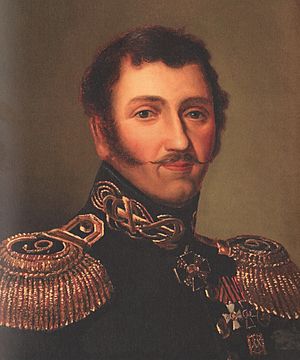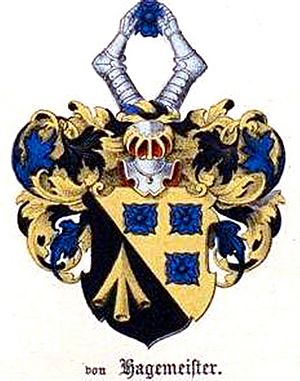Ludwig von Hagemeister facts for kids
Quick facts for kids
Ludwig von Hagemeister
|
|
|---|---|
 |
|
| 2nd Governor of Russian America | |
| In office January 11, 1818 – October 24, 1818 |
|
| Preceded by | Alexander Andreyevich Baranov |
| Succeeded by | Semyon Yanovsky |
| Personal details | |
| Born | 16 June [O.S. 5] 1780 Drostenhof, Kreis Wenden, Governorate of Livonia, Russian Empire |
| Died | 3 January [O.S. 22 December 1833] 1834 (aged 53) Saint Petersburg, Russian Empire |
| Nationality | Baltic German |
Ludwig Karl August von Hagemeister was a brave Russian naval officer and explorer. He sailed the seas, exploring places like Alaska and the Pacific Ocean. For a short time, from 1817 to 1818, he was the second leader of the Russian-American Company, which was a big trading company.
Contents
Ludwig von Hagemeister was born in 1780 into a Baltic German family in the Russian Empire. He started his journey in the Russian navy in 1795 as a young volunteer. In 1802, he even joined the British Royal Navy for a while to gain more experience.
First Trip Around the World
In 1806, Hagemeister was given an important mission. He was to sail the ship Neva to Russian America (which is now Alaska) with supplies. This was the first of three times he would sail all the way around the world!
He left Russia on October 20, 1806. The Neva sailed south across the Atlantic Ocean, went around the continent of Africa, and then headed east. After passing the Cape of Good Hope, Hagemeister and his crew became the first Russians to visit Australia. They arrived at Port Jackson on June 4.
Exploring Alaska and Hawaii
On September 13, the Neva reached New Archangel (now Sitka, Alaska) in Russian America. Hagemeister spent most of 1808 on Kodiak Island. At that time, Russian forces were in conflict with the Tlingit people.
The leader of the Russian-American Company, Alexander Andreyevich Baranov, asked Hagemeister to get supplies from the Kingdom of Hawaii. He also wanted Hagemeister to look for a good place to start a new Russian settlement there. In early 1809, Hagemeister explored parts of the North Pacific and met with King Kamehameha I of Hawaii. They had friendly talks, and Hagemeister bought a lot of salt. After delivering the salt to New Archangel, he sailed back to Saint Petersburg in 1810.
Recognition and New Roles
When Hagemeister returned to Russia, his trip around the world was celebrated. He was promoted to a higher rank and received an important award called the Order of St. Vladimir. From 1812 to 1815, he led the Admiralty of Irkutsk. In this role, he was in charge of building the first ships to cross Lake Baikal.
Leading Russian America
Another explorer, Vasily Golovnin, encouraged Hagemeister to plan another trip to New Archangel. Hagemeister was chosen to lead a ship for the Russian-American Company again. This time, besides delivering supplies, he was asked to check how the company's leader, Baranov, was managing money. He was also given the power to replace Baranov if he thought it was needed. Baranov, who was 70 years old, had been asking to retire for years.
In 1816, Hagemeister began his second trip around the world on the ship Kutuzov. He arrived in New Archangel in 1817 with his second-in-command, Semyon Yanovsky.
Building Fort Ross
Before looking at Baranov's financial records, Hagemeister traveled to northern California. He wanted to make official agreements with the Kashia Pomo people. He was the main person talking with the local Pomo leaders. He got permission to build Fort Ross.
On September 22, 1817, they signed an agreement. Tribal leaders were happy to have Russians there because it made them safer from other tribes. This agreement was part of a plan by the Russian-American Company to take over Alta California from the Spanish Empire.
Taking Over as Governor
When Hagemeister returned to New Archangel, he and other naval officers spent the winter checking the company's financial records. On January 11, 1818, Hagemeister removed Baranov from his position.
Hagemeister then became the new leader. He changed how workers were paid, giving them money instead of shares in goods. He also worked to improve relations with the Hawaiian Kingdom, which had been difficult before. Hagemeister made a rule that only Europeans from the Russian-American Company could trade in the area. This rule was later made into a law by the Russian government in 1821. This law also claimed more land for Russia, reaching into northern California, and banned all non-Russian European traders from the area.
Hagemeister chose his second-in-command, Semyon Ivanovich Yanovsky, to be the next leader. In late October 1818, Hagemeister and Baranov left New Archangel. Baranov was happy to finally be going back to Russia. Sadly, Baranov died at sea in 1819 and was buried there.
Later Life and Legacy
From 1828 to 1829, Hagemeister made his last trip around the world on the ship Krotky. During this journey, he explored the Menshikov Atoll (Kwajalein) in the Marshall Islands. He mapped it and marked the locations of other islands. His personal diaries were written in several languages, including German, Russian, French, Portuguese, English, and Spanish.
Places Named After Him
- Hagemeister Island in Alaska was named in his honor.
- Hagemeister Strait in Alaska was also named after him.


